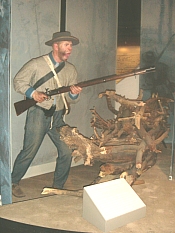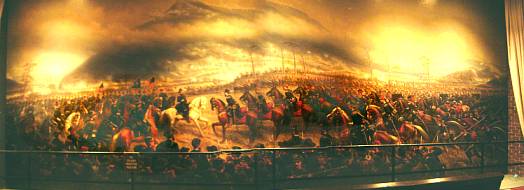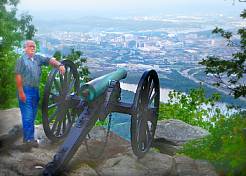In
1863, Both Generals understood the importance of the rail system that centered
in Chattanooga and were determined to control the town. In early September,
Rosecrans decided to end the affray and marched out of Chattanooga to meet
Bragg, south of the city. Twenty Six miles south of the city, Rosecrans' men
found Braxton Bragg and the Confederate forces near LaFayette. Bragg’s plan
was to send his confederate troop behind the advancing Union lines, positioning
them between the Union forces and Chattanooga, cutting them off from supplies
and collapsing their support. After several failed attempts, On September 19th General Bragg tried again only to
have his initial force run into a Union patrol at
Jay's Mill on Brotherton Rd. Union and Confederate forces traded shots
and stabs from bayonets as a major battle developed over a 4 mile line, until
the Union settled behind log emplacements along the LaFayette road, which ran
North to South. This set up the
events of September 20th, 1863.
Unlike other Civil War battles that were fought on open fields,
Chickamauga was fought in mostly wooded terrain. Generals had trouble keeping track of their troops much less
directing them. For two days the
combatants slugged it out in near hand to hand combat until thousands lay dead
behind trees and rocks. Ever
Both Generals understood the importance of the rail system that centered
in Chattanooga and were determined to control the town. In early September,
Rosecrans decided to end the affray and marched out of Chattanooga to meet
Bragg, south of the city. Twenty Six miles south of the city, Rosecrans' men
found Braxton Bragg and the Confederate forces near LaFayette. Bragg’s plan
was to send his confederate troop behind the advancing Union lines, positioning
them between the Union forces and Chattanooga, cutting them off from supplies
and collapsing their support. After several failed attempts, On September 19th General Bragg tried again only to
have his initial force run into a Union patrol at
Jay's Mill on Brotherton Rd. Union and Confederate forces traded shots
and stabs from bayonets as a major battle developed over a 4 mile line, until
the Union settled behind log emplacements along the LaFayette road, which ran
North to South. This set up the
events of September 20th, 1863.
Unlike other Civil War battles that were fought on open fields,
Chickamauga was fought in mostly wooded terrain. Generals had trouble keeping track of their troops much less
directing them. For two days the
combatants slugged it out in near hand to hand combat until thousands lay dead
behind trees and rocks. Ever y battle
starts with a General’s decision to go on the the offensive or “attack”.
The opposing General has only three options, counterattack , defend or run.
Bragg, determined to re-take Chattanooga, attacked for the third day.
General Bragg started the day off with a flanking maneuver to roll around
the North end, hoping to collapse the Union forces toward the south.
General Rosecrans pulled troops from his south end to reinforce the
north. In what would now be a
complete impossibility, General Rosecrans received an intelligence report that one of his
Generals was not where he was suppose to be, creating a hole in the Union line.
Although this would later to be proven false, Rosecrans, acting on the
report pulled his troops out of the middle to fill the imaginary hole.
No sooner did the last of these troops pull back then the Confederates
came pouring out of the woods and through the new hole. Within a few hours the
Confederates had rolled up the defenders sending most of them scurrying back to
Chattanooga. Two notable exceptions: Troops
under the command of Gen. George Thomas set up a second line of defense on top
of Snodgrass Hill, where they repelled many head-on attacks before being
recalled to the city by General Rosecrans.
The other exception was Col. John Wilder, who ordered his Brigade of
Union Cavalry to attack. What had seemed like a suicide mission by the Confederate
attackers was quickly changed as Confederate troop fell in mass to the new
Springfield repeating rifle just issued to the cavalry.
The time bought by this charge gave General Thomas time to establish his
line and prepare for the coming attacks. The Union forces on Snodgrass Hill
threw off attack after attack until the hill was littered with dead and dying,
still the Confederate attackers could not breach the defenses.
With plenty of fight still in him, Thomas received orders from
Chattanooga to withdraw back into the city.
While the Confederacy regrouped for yet another attack up the hill, the
Union forces slipped away and vanished into the city.
Thus the battle of Chickamauga ended and the battle for Chattanooga
began.
y battle
starts with a General’s decision to go on the the offensive or “attack”.
The opposing General has only three options, counterattack , defend or run.
Bragg, determined to re-take Chattanooga, attacked for the third day.
General Bragg started the day off with a flanking maneuver to roll around
the North end, hoping to collapse the Union forces toward the south.
General Rosecrans pulled troops from his south end to reinforce the
north. In what would now be a
complete impossibility, General Rosecrans received an intelligence report that one of his
Generals was not where he was suppose to be, creating a hole in the Union line.
Although this would later to be proven false, Rosecrans, acting on the
report pulled his troops out of the middle to fill the imaginary hole.
No sooner did the last of these troops pull back then the Confederates
came pouring out of the woods and through the new hole. Within a few hours the
Confederates had rolled up the defenders sending most of them scurrying back to
Chattanooga. Two notable exceptions: Troops
under the command of Gen. George Thomas set up a second line of defense on top
of Snodgrass Hill, where they repelled many head-on attacks before being
recalled to the city by General Rosecrans.
The other exception was Col. John Wilder, who ordered his Brigade of
Union Cavalry to attack. What had seemed like a suicide mission by the Confederate
attackers was quickly changed as Confederate troop fell in mass to the new
Springfield repeating rifle just issued to the cavalry.
The time bought by this charge gave General Thomas time to establish his
line and prepare for the coming attacks. The Union forces on Snodgrass Hill
threw off attack after attack until the hill was littered with dead and dying,
still the Confederate attackers could not breach the defenses.
With plenty of fight still in him, Thomas received orders from
Chattanooga to withdraw back into the city.
While the Confederacy regrouped for yet another attack up the hill, the
Union forces slipped away and vanished into the city.
Thus the battle of Chickamauga ended and the battle for Chattanooga
began.
From the visitor center it was a short 7 mile drive through the
battlefield, after which, we headed out to climb Lookout Mountain in nearby
Tennessee. The road is winding and
steep. I would not have wanted to
carry a thousand pound cannon up a dirt road to the top.
Reaching the  summit, we found Lookout Mountain National Park.
This is a pay park. Sorry, that wonderful Golden Age Pass won’t get you
in. It will take cash,
$1,50 per adult, in conjunction with the pass.
The view was spectacular and I was able to take a position behind one of
these huge 12 ponders, to get the feel of what it must have been like firing on
river and road far below. Should you decide to save the buck and a half, still
see the Point Park visitor center and listen to the 7 minute description of
James Walker’s 13’x33’ mural , “Battle of Lookout Mountain"
on display there. Walker was an eyewitness of the battle and was commissioned by
General Hooker to paint the battle scene for $20,000. This was Hooker’s (white
horse in center) insurance that he would be remembered for his role in the Greatest War America
ever fought.
summit, we found Lookout Mountain National Park.
This is a pay park. Sorry, that wonderful Golden Age Pass won’t get you
in. It will take cash,
$1,50 per adult, in conjunction with the pass.
The view was spectacular and I was able to take a position behind one of
these huge 12 ponders, to get the feel of what it must have been like firing on
river and road far below. Should you decide to save the buck and a half, still
see the Point Park visitor center and listen to the 7 minute description of
James Walker’s 13’x33’ mural , “Battle of Lookout Mountain"
on display there. Walker was an eyewitness of the battle and was commissioned by
General Hooker to paint the battle scene for $20,000. This was Hooker’s (white
horse in center) insurance that he would be remembered for his role in the Greatest War America
ever fought.
The
 end of the battle for Chickamauga signaled the opening of the battle for
Chattanooga. With the Union troops safely back in the city, General Bragg knew
he didn’t have the strength to win what would certainly become a long siege.
He took his next best option. He
ordered his artillery to be hauled to the top of Lookout Mountain.
From there shells rained down on the Tennessee River traffic and all
roads thereabouts. With more Confederate
troops holding key road crossings around the city, cutting off most of the
supplies destined for the Union defenders, it soon became apparent that
Rosecrans’ army would have to surrender or starve.
Washington, realizing the peril at Chattanooga, sent three of the
Union’s best Generals to the rescue. Joseph
Hooker marched in from the Northeast with some 20,000 men while William T.
Sherman came up from the Southwest with another 16,000 men. To head up the
relief effort, Lincoln sent in his latest success, fresh from the siege of
Vicksburg, Ulysses S. Grant, who took
command of all forces in Tennessee. By the end of October, the Union had
end of the battle for Chickamauga signaled the opening of the battle for
Chattanooga. With the Union troops safely back in the city, General Bragg knew
he didn’t have the strength to win what would certainly become a long siege.
He took his next best option. He
ordered his artillery to be hauled to the top of Lookout Mountain.
From there shells rained down on the Tennessee River traffic and all
roads thereabouts. With more Confederate
troops holding key road crossings around the city, cutting off most of the
supplies destined for the Union defenders, it soon became apparent that
Rosecrans’ army would have to surrender or starve.
Washington, realizing the peril at Chattanooga, sent three of the
Union’s best Generals to the rescue. Joseph
Hooker marched in from the Northeast with some 20,000 men while William T.
Sherman came up from the Southwest with another 16,000 men. To head up the
relief effort, Lincoln sent in his latest success, fresh from the siege of
Vicksburg, Ulysses S. Grant, who took
command of all forces in Tennessee. By the end of October, the Union had  again
established a supply line and was prepared to take the fight to the hills.
On November 24 the Union attacked Lookout Mountain in what was to become
“The Battle in the Clouds”. After
a thick fog had settled in about halfway to the mountain,
Union troops slipped up the hillside and engaged the defenders at Cravens
House. Having pushed the Confederacy out of most of its defense positions, Grant
concentrated his forces on Missionary Ridge, just west of the City. For a while
it seemed that the defenders would be able to hold the Ridge against
overwhelming odds. As the afternoon
wore on, Grant sent Rosecrans' original force, now under Thomas to the base
of Missionary Ridge in hopes of
relieving pressure on Sherman who had been stopped.
In what would become one of
the great military charges of the entire war,
Thomas’ men, without orders to do so, charged up the heights and
attacked the Confederate center. In
disbelief, the Rebel line collapsed and Bragg was forced to withdraw.
Later that night he and his men would slip away into Georgia, leaving
Grant with a vital rail service to the North and West.
Chattanooga would become one of the North’s biggest supply depots, and
in the Spring, Sherman would use the city to launch his infamous “March to the
Sea” where he would sack Atlanta
again
established a supply line and was prepared to take the fight to the hills.
On November 24 the Union attacked Lookout Mountain in what was to become
“The Battle in the Clouds”. After
a thick fog had settled in about halfway to the mountain,
Union troops slipped up the hillside and engaged the defenders at Cravens
House. Having pushed the Confederacy out of most of its defense positions, Grant
concentrated his forces on Missionary Ridge, just west of the City. For a while
it seemed that the defenders would be able to hold the Ridge against
overwhelming odds. As the afternoon
wore on, Grant sent Rosecrans' original force, now under Thomas to the base
of Missionary Ridge in hopes of
relieving pressure on Sherman who had been stopped.
In what would become one of
the great military charges of the entire war,
Thomas’ men, without orders to do so, charged up the heights and
attacked the Confederate center. In
disbelief, the Rebel line collapsed and Bragg was forced to withdraw.
Later that night he and his men would slip away into Georgia, leaving
Grant with a vital rail service to the North and West.
Chattanooga would become one of the North’s biggest supply depots, and
in the Spring, Sherman would use the city to launch his infamous “March to the
Sea” where he would sack Atlanta
For Civil War buffs, this would be an important point of study. It is considered one of the strategic campaigns of the war. Chattanooga has returned to a charming little town overlooking the Tennessee River. The Riverfront is particularly picturesque. The views from Point Park are spectacular as expected, be sure to take binoculars. All in all, this is a great area to visit for a few days.
***THE END ***

